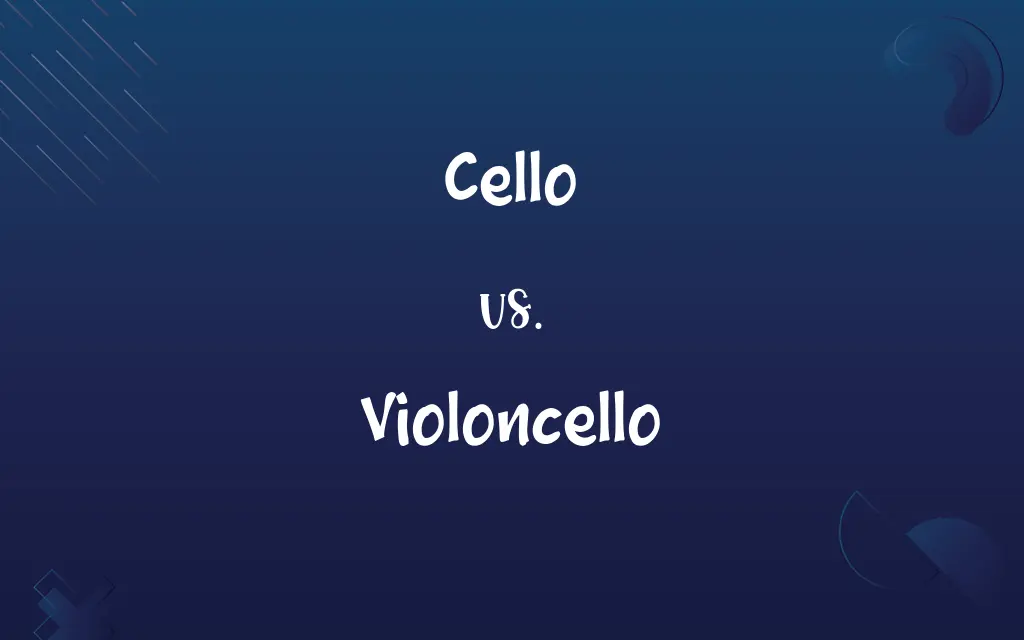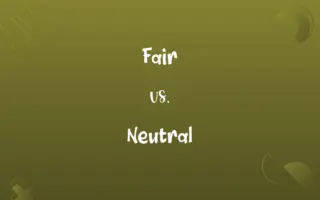Cello vs. Violoncello: Know the Difference

By Hifza Nasir & Dua Fatima || Updated on March 5, 2024
Cello and violoncello refer to the same string instrument, with "cello" being the common abbreviation.

Key Differences
The cello, short for violoncello, is a bowed string instrument with a rich, deep sound, playing a crucial role in orchestras and chamber music. While "cello" is the term widely used by musicians and in everyday language, "violoncello" is its full Italian name, suggesting a smaller version of the violone, a larger bass instrument.
Hifza Nasir
Mar 05, 2024
Both terms refer to the same instrument, known for its versatility and ability to mimic the human voice, from deep, sonorous lows to vibrant, expressive highs. The cello plays a central role in classical music, with a repertoire that spans solo, chamber, and orchestral works. The transition from "violoncello" to "cello" reflects a common trend in language to simplify and shorten terms for ease of communication, without altering the essence or function of the instrument.
Hifza Nasir
Mar 05, 2024
In terms of construction, there is no difference between instruments labeled as cellos or violoncellos; the terms are purely linguistic variations. The cello is distinguished by its large body, four strings tuned an octave lower than the viola, and its played seated with the instrument between the knees.
Hifza Nasir
Mar 05, 2024
The choice between "cello" and "violoncello" often comes down to tradition, formality, or personal preference. Conversely, "cello" is universally recognized and used in casual and professional contexts alike, emphasizing the instrument's accessibility and enduring popularity.
Shumaila Saeed
Mar 05, 2024
Despite the difference in nomenclature, the instrument's role and significance in music remain unchanged. Whether referred to as a cello or violoncello, it continues to captivate audiences with its deep, resonant sound and emotional expressiveness. Understanding the etymology and use of both terms enriches one's appreciation for the instrument's history and cultural significance.
Shumaila Saeed
Mar 05, 2024
ADVERTISEMENT
Comparison Chart
Name Origin
Abbreviated form of "violoncello."
Italian, meaning "small violone."
Hifza Nasir
Mar 05, 2024
ADVERTISEMENT
Cello and Violoncello Definitions
Cello
Bowed string instrument.
The cello's deep, resonant tones add warmth to the orchestra's sound.
Hifza Nasir
Mar 05, 2024
Violoncello
Same playing technique.
Mastery of the violoncello requires years of dedicated practice and technique development.
Dua Fatima
Mar 05, 2024
Cello
Versatile repertoire.
The cello is celebrated for its solo pieces as well as its role in chamber music.
Hifza Nasir
Mar 05, 2024
Violoncello
Historical context.
The violoncello has evolved significantly since its creation in the 16th century.
Hifza Nasir
Mar 05, 2024
Cello
Played seated.
Cellists play seated, cradling the instrument between their knees for stability.
Hifza Nasir
Mar 05, 2024
ADVERTISEMENT
Violoncello
Reflects tradition.
Using violoncello in academic papers emphasizes the instrument's classical heritage.
Hifza Nasir
Mar 05, 2024
Cello
Widely used term.
She took up the cello because of its expressive range and versatility.
Hifza Nasir
Mar 05, 2024
Violoncello
Full Italian name for cello.
The violoncello, with its rich tones, has been a cornerstone of classical music for centuries.
Hifza Nasir
Mar 05, 2024
Cello
Accessible name.
Cello is the term most people use to refer to this beautiful string instrument.
Hifza Nasir
Mar 05, 2024
Violoncello
Formal usage.
The program listed his performance as a Concerto for Violoncello and Orchestra.
Dua Fatima
Mar 05, 2024
Cello
A large unfretted stringed instrument of the violin family with four strings tuned (lowest to highest) C-G-D-A and an endpin to support its weight, usually played with a bow.
Hifza Nasir
Oct 19, 2023
Violoncello
A stringed instrument of music; a bass viol of four strings, or a bass violin with long, large strings, giving sounds an octave lower than the viola, or tenor or alto violin.
Hifza Nasir
Oct 19, 2023
Violoncello
A large stringed instrument; seated player holds it upright while playing
Hifza Nasir
Oct 19, 2023
Cello
A large stringed instrument; seated player holds it upright while playing
Hifza Nasir
Oct 19, 2023
Cello
A four-stringed musical instrument of the violin family, pitched lower than the viola but higher than the double bass.
Hifza Nasir
Oct 19, 2023
Repeatedly Asked Queries
Are the cello and violoncello different instruments?
No, the cello and violoncello refer to the same instrument; "cello" is simply an abbreviation of "violoncello."
Hifza Nasir
Mar 05, 2024
Can the cello be played as a solo instrument?
Yes, the cello is frequently played solo, with a vast repertoire of solo pieces showcasing its lyrical quality and emotional depth.
Hifza Nasir
Mar 05, 2024
Why is the cello often used in orchestras?
The cello is valued in orchestras for its wide range, capable of playing both melody and harmony, and its ability to produce a sound that blends well with other instruments.
Dua Fatima
Mar 05, 2024
What does "violoncello" mean?
"Violoncello" is the full Italian name for the cello, meaning "small violone," a reference to its size compared to the larger bass instrument, the violone.
Dua Fatima
Mar 05, 2024
What is a cello?
A cello is a bowed string instrument with a deep, rich sound known for its expressiveness and versatility in classical music.
Hifza Nasir
Mar 05, 2024
Is there a difference in how "cello" and "violoncello" are used today?
Today, "cello" is the term more commonly used by musicians and in everyday language, while "violoncello" may be preferred in formal, academic, or historical contexts.
Hifza Nasir
Mar 05, 2024
What role does the cello play in chamber music?
In chamber music, the cello often provides the bass line, supporting the harmonic foundation and enriching the ensemble's sound.
Shumaila Saeed
Mar 05, 2024
How has the design of the cello evolved over time?
The design of the cello has evolved to enhance its sound and playability, including changes in the shape of the body, the length of the neck, and the construction of the bow.
Hifza Nasir
Mar 05, 2024
What is the typical range of a cello?
The cello's pitch range extends from deep, resonant lows to vibrant, expressive highs, covering nearly four octaves.
Hifza Nasir
Mar 05, 2024
How is the cello tuned?
The cello is tuned in fifths, from low to high: C2, G2, D3, and A3, an octave lower than the viola.
Hifza Nasir
Mar 05, 2024
Share this page
Link for your blog / website
HTML
Link to share via messenger
About Author
Written by
Hifza NasirCo-written by
Dua Fatima






































































